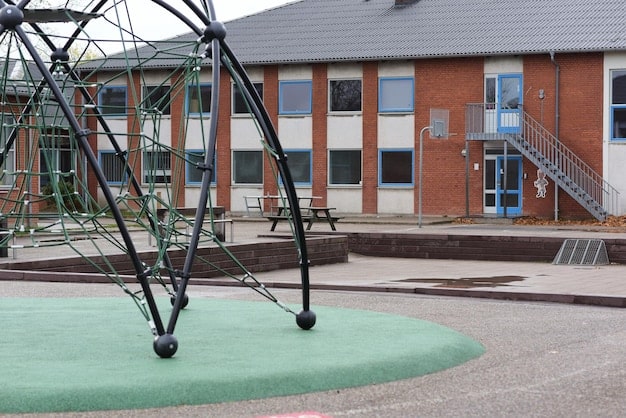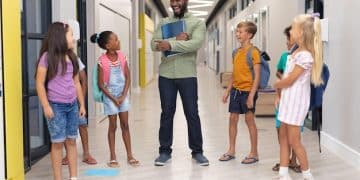Child Safety: Preventing Accidents and Injuries at Home and School

Child safety is crucial both at home and school, requiring proactive measures to prevent accidents and injuries through hazard awareness, safety education, and creating secure environments.
Ensuring the safety of children is a top priority for parents, educators, and communities alike. Accidents and injuries can happen quickly, but understanding potential hazards and taking preventive measures can significantly reduce the risk. This article explores essential strategies for child safety: preventing accidents and injuries at home and school.
Understanding Child Safety: A Comprehensive Approach
Child safety encompasses a wide range of practices aimed at protecting children from potential harm. A comprehensive approach involves identifying common risks, implementing safety protocols, and fostering a culture of awareness among both children and adults.
Identifying Common Hazards
Identifying common hazards is the first step in creating a safe environment for children. These hazards can vary depending on the setting, but some are consistently prevalent. Recognizing these risks allows for targeted preventive measures.
- At Home: Common hazards include unsecured medications, cleaning supplies, sharp objects, and unprotected electrical outlets.
- At School: School environments may present risks such as playground equipment, sports-related injuries, and exposure to allergens.
- General Risks: Regardless of the location, risks such as falls, burns, poisoning, and choking are always a concern.
By identifying these common hazards, parents and educators can take proactive steps to mitigate these risks and protect children from potential harm.
Creating a Safe Home Environment
The home should be a safe haven for children, but it can also be a place where accidents frequently occur. Creating a safe home environment involves making modifications, implementing safety rules, and continuously monitoring potential hazards.

Home Safety Checklist
A home safety checklist can serve as a practical guide for identifying and addressing potential hazards. Regular inspections and updates to safety measures are essential for maintaining a safe environment.
- Secure Medications and Cleaning Supplies: Store all medications and cleaning supplies in locked cabinets or out of reach of children.
- Install Safety Gates: Use safety gates at the top and bottom of staircases to prevent falls.
- Cover Electrical Outlets: Install outlet covers to prevent children from inserting objects into electrical sockets.
- Smoke and Carbon Monoxide Detectors: Ensure that smoke and carbon monoxide detectors are installed and functioning properly.
Implementing these measures can significantly reduce the risk of accidents and injuries within the home environment.
Promoting Safety at School
Schools play a crucial role in promoting child safety. This involves implementing safety policies, providing adequate supervision, and educating students about potential risks.
School Safety Policies and Procedures
Clear and comprehensive safety policies are essential for maintaining a safe school environment. These policies should address a range of issues, from bullying and harassment to emergency preparedness.
Schools should have procedures in place for handling medical emergencies, reporting accidents, and addressing safety concerns raised by students, parents, or staff members. Regular reviews and updates to these policies can help ensure their effectiveness.
Educating Students About Safety
Educating students about safety is a proactive approach to preventing accidents and injuries. This can involve teaching students about potential hazards, promoting safe behaviors, and empowering them to take responsibility for their own safety and the safety of others.
- Stranger Danger: Educate students about the dangers of interacting with strangers and provide them with strategies for staying safe.
- Bullying Prevention: Implement anti-bullying programs that teach students about the impact of bullying and provide them with tools for intervening and reporting incidents.
- Traffic Safety: Teach students about pedestrian and bicycle safety, including how to cross the street safely and wear helmets.
By educating students about safety, schools can create a culture of awareness and promote responsible decision-making.

Preventing Common Childhood Injuries
Despite best efforts, accidents can still happen. Understanding how to prevent common childhood injuries can help parents and educators minimize risks and protect children from harm.
Preventing Falls
Falls are a leading cause of injury among children. Taking steps to prevent falls can significantly reduce the risk of serious injuries.
Installing handrails on staircases, using non-slip mats in bathrooms, and ensuring that play areas have soft landing surfaces can help prevent falls. Parents and educators should also teach children about safe climbing practices and the importance of avoiding risky behaviors.
Preventing Burns
Burns can be extremely painful and can result in long-term complications. Preventing burns involves taking precautions around hot surfaces, liquids, and chemicals.
- Hot Water Safety: Set the water heater to a safe temperature (no higher than 120°F) to prevent scalding.
- Cooking Safety: Keep children away from hot stoves and ovens, and never leave cooking food unattended.
- Chemical Safety: Store chemicals in locked cabinets and away from children, and always supervise children when they are using chemicals.
By implementing these measures, parents and educators can reduce the risk of burns and protect children from serious harm.
In conclusion, preventing common childhood injuries requires a multifaceted approach that includes creating safe environments, educating children and adults about potential hazards, and implementing preventive measures.
Emergency Preparedness and First Aid
Being prepared for emergencies is an essential aspect of child safety. Knowing how to respond to different types of emergencies can make a significant difference in the outcome.
First Aid Training and Certification
First aid training and certification are valuable skills for parents, educators, and anyone who works with children. These courses provide individuals with the knowledge and skills to respond effectively to medical emergencies.
CPR, wound care, and managing allergic reactions are essential components covered in first aid training. Regular refresher courses can help individuals stay up-to-date on the latest best practices.
Emergency Contact Information
Having readily available emergency contact information is crucial in the event of an accident or injury. This information should include phone numbers for parents, guardians, doctors, and local emergency services.
Emergency contact information should be stored in multiple locations, such as on cell phones, in wallets, and in easily accessible locations at home and school. This ensures that first responders have the information they need to provide prompt and effective care.
The Role of Technology in Child Safety
Technology plays an increasingly important role in child safety, offering tools and resources that can help parents and educators protect children from harm.
Child Safety Apps and Devices
Child safety apps and devices can provide parents with enhanced monitoring and communication capabilities. These tools can help parents keep track of their children’s whereabouts, monitor their online activities, and communicate with them in real-time.
- GPS Trackers: GPS trackers can be attached to children’s backpacks or clothing, allowing parents to monitor their location.
- Parental Control Apps: Parental control apps can be used to restrict access to inappropriate content, monitor social media activity, and limit screen time.
- Emergency Alert Systems: Emergency alert systems can be used to send out notifications about potential dangers or emergencies in the area.
By leveraging these technologies, parents can enhance their ability to protect children from potential harm.
| Key Point | Brief Description |
|---|---|
| 🏠 Home Safety | Secure medications, install safety gates, and cover electrical outlets. |
| 🏫 School Safety | Implement safety policies, provide supervision, and educate students. |
| 🩹 Injury Prevention | Prevent falls and burns through proactive measures and education. |
| 📱 Tech Safety | Use child safety apps and devices to monitor and protect children. |
Frequently Asked Questions
What are the most common home hazards for young children?
▼
Common hazards include unsecured medications and cleaning supplies, unprotected electrical outlets, sharp objects, and the risk of falls from stairs or furniture. Securing these areas is key to childproofing.
What should be included in a school’s emergency preparedness plan?
▼
An emergency plan should cover medical emergencies, severe weather, lockdowns, and evacuation procedures. Regular drills and communication protocols are essential for effective implementation.
What can parents do to prevent falls in the home?
▼
Parents can install safety gates on stairs, use non-slip mats in bathrooms, secure furniture to walls, and keep floors clutter-free. Educating children about safe climbing practices is also important.
How can schools educate students about bullying prevention?
▼
Schools can implement anti-bullying programs, teach students about empathy and respect, encourage reporting of incidents, and create a supportive environment where bullying is not tolerated.
What role do technology and gadgets play in child safety?
▼
Technology offers tools like GPS trackers, parental control apps, and emergency alert systems. While helpful, these should complement, not replace, direct supervision and open communication with children.
Conclusion
Prioritizing child safety: preventing accidents and injuries at home and school requires a coordinated effort between parents, educators, and the community. By implementing preventive measures, fostering a culture of awareness, and leveraging available resources, we can create safer environments for children to learn, grow, and thrive.





